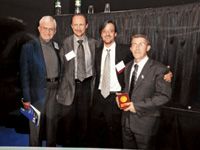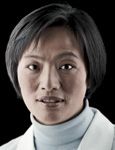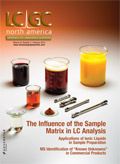Man of the Masses
LCGC North America
An interview with Fred McLafferty, professor emeritus at Cornell University, about his pioneering career in mass spectrometry
"MS: The Practical Art" Editor, Kate Yu, spoke to Fred McLafferty, professor emeritus at Cornell University, about his pioneering career in mass spectrometry.
Kate Yu: What brought you into the field of mass spectrometry (MS)?
Fred McLafferty: A crazy coincidence! After a PhD at Cornell University (Ithaca, New York) and a postdoctoral at the University of Iowa (Iowa City, Iowa), I arrived at the Dow Chemical Co. in 1950 for an interview in their organic chemistry research laboratory. However, Dow also interviewed me for their spectroscopy laboratory in the MS group of Vic Caldecourt and two instrument operators. Vic had made the MS analyses so popular within the company that Dow wanted a chemist for the increased sample load while he concentrated on maintaining and improving the cranky instrumentation, at which he was terrific. No one, not even me, understood why I took the job with absolutely no prior knowledge (1).

Figure 1: Bendix time-of-flight mass spectrometer at the Dow Chemical Company with Roland Gohlke (foreground) and Fred McLafferty.
KY: You were in World War II and were awarded the Combat Infantryman Badge. What were the most remarkable experiences you remember during the war?
FM: I went on active duty in April 1943, just after finishing a B.S. in chemistry and mathematics at the University of Nebraska (Lincoln, Nebraska). A month before the war ended in Europe, our 2nd Battalion, 253rd Infantry, captured a major remaining German ammunition depot in a fierce battle against an elite SS unit that promised Hitler "no retreat." The battalion members were awarded a Presidential Unit Citation. During this action, platoon sergeant John R. Crews of my rifle company was awarded the Congressional Medal of Honor for personally saving part of another company that was trapped. I was wounded earlier the same day.
KY: Why did you come back to the field of chemistry after the war?
FM: I was offered a battlefield commission from sergeant to officer rank, so I had a "career choice," but I doubt that such a career would allow the "fun participation" that I am having at my present age.

KY: Looking back at your career, who was the most influential person for you?
FM: Professor Franklin A. Long, who was at the Cornell University Chemistry Department from 1937 to 1999, was a very special scientific role model and friend during my graduate work from 1947 to 1949, and after I joined the faculty in 1968. He was a member of the National Academy of Sciences, Assistant Director of the US Arms Control and Disarmament Agency, and on the Science Advisory Committees for three US Presidents. But by far the most important person in my life for 65 years has been my wonderful wife: Elizabeth "Tibby" Curley McLafferty.
KY: Tell us about your experiences at Dow Chemical. How did you develop the gas chromatography–mass spectrometry (GC–MS) instrument?
FM: Dow's spectroscopy laboratory was one of the best in "modern" high information methods including direct reading atomic emission spectroscopy (AES), X-ray diffraction (XRD), infrared (IR), nuclear magnetic resonance (NMR) spectroscopy, and MS. Dow was also unusually supportive of any new MS applications and related research. At a 1954 Gordon Research Conference, friend Steve Dal Nogare of DuPont and H.N. Wilson from Imperial Chemistry Industries (ICI), told me about GC with full details on how to build one. Soon after, Roland Gohlke, who worked with me, developed an improved version to solve problems in Dow laboratories and plants. For example, Roland put the column, a 25-ft copper tubing coil, in a 2-L Dewar for better temperature control and often used Tide detergent as a column packing.

Figure 2: Time-of-flight mass spectra (oscillograph display) typical of Dow’s early GCâMS capabilities: (a) mass spectrum of methane (CH4), peaks at m/z 12â17 (16 tallest); (b) mass spectrum of acetone (C4H6O, MW 58), peaks at 13â59 (contains impurity peaks, for example, H2O).
In addition, my friends Bill Wiley and Dan Harrington at nearby Bendix Research Labs were just commercializing their time-of-flight (TOF) MS instrument (10,000 spectra/s), and were happy to let us try coupling our GC to the TOF in February 1956. It was very exciting to see on the output oscilloscope the rise and fall of unit-resolution spectra of acetone, benzene, and toluene, the first organic compounds run on their TOF instrument (2).
KY: How did you discover the famous McLafferty Rearrangement and what sort of impact did it have on mass spectrometry?
FM: The infrared capabilities of Dow's spectroscopy laboratory were worldclass, helped by the spectroscopy team's extensive efforts to collect a large spectral database of organic compounds. Consequently, during any spare MS instrument time we had, we continued this to build up an MS spectral database using the extensive sample collection available, giving us the mass spectra of many compound classes. This made it possible by 1956 to show a general correlation of novel hydrogen rearrangements (3), although individual cases had previously been reported.

Figure 3: Fred McLafferty (far left); Roman Zubarev, Professor of Medical Proteomics in the Department of Medical Biochemistry and Biophysics at the Karolinska Institutet (Stockholm, Sweden), who also directs the institute's large LCâMS proteomics facility; Dr. Gary Valaskovic, cofounder and CEO of New Objective (Woburn, Massachusetts); and Neil Kelleher, Professor in Chemistry, Molecular Biosciences and the Feinberg School of Medicine of Northwestern University (Chicago, Illinois), who also directs the large LCâMS proteomics facility in Chicago. The photo was taken by Dr. Susan Weintraub at the ASMS meeting (Philadelphia, Pennsylvania) in June 2009.
At that time Dow sent me to the Boston area to set up a corporate laboratory for basic research. Although for my personal research I had no MS instrument, the structural diversity of our MS database was already unique, allowing extensive details of single and double hydrogen atom rearrangements to be established (4). This helped to show the key role of odd-electron ions in MS ion dissociation mechanisms and convince organic chemists that mass spectra were based on real chemistry.
KY: Why did you go back to university while having a fantastic career in industry at the time?
FM: The success of Dow's new basic research laboratory depended on selling its research capabilities to the academic community, as well as to meet Dow objectives. New hires found a novel research opportunity with industrial level support. We did recruit great people, including later Nobel Laureate George Olah. But in trying to sell my industrial research to academe, they sold me on academia. In 1964 I went to Purdue University (West Lafayette, Indiana) as professor of chemistry.
KY: You've made many great contributions to mass spectrometry over the years. What do you think is your greatest contribution?
FM: In 1950 MS was dominated by measurements of isotope ratios, atomic weights, and hydrocarbon mixtures, while my main research efforts since then have been in "molecular mass spectrometry." The current reversal in dominance came through a long series of developments that our research contributed to. These included an improved understanding of new ion-radical chemistry; advances in GC–MS, LC–MS, and MS-MS instrumentation; advances in techniques, such as collisional activated dissociation, neutralization–reionization, and electron capture dissociation; improved computer data acquisition, reduction, and identification using collected reference data (5); and developments in top-down characterization of biomolecules and gaseous protein conformers (1). It was the combined efforts of the unusually cooperative researchers of many MS laboratories that made these advances possible.
KY: Among all the awards you have received, which one was the most remarkable award to you?
FM: Al Bard and I were elected to the US National Academy of Sciences in 1982; before that, the only analytical chemists elected were I.M. "Pete" Kolthoff (1958) and Charlie Reilley (1977). Best of all, I have also been awarded a most remarkable family of five children and 10 grandchildren.
KY: What major challenges remain in mass spectrometry? Which ones do you think the younger generation should focus on?
FM: The huge growth of MS removes its applications further from the basic research that makes more of this growth possible. Education awareness requires updated textbooks, "short courses," consultants, and most importantly, improved communication in our field. The positions of those supporting "bottom-up" versus "topdown" approaches appear to have shifted little in the last decade.
KY: Where do you think the future of mass spectrometry lies?
FM: As in 1950, I believe that the future is still in "molecular mass spectrometry." But now we see more clearly the amazing enhancements possible with far greater mass range (megadalton plus) and resolving power, coupled separation techniques (for example, MS with chromatography, ion mobility) and computerized automation. These can be applied to an even broader range of critical areas of basic knowledge and practical problems.
KY: Is there any advice you would give to young scientists embarking on a career in analytical chemistry?
FM: Young scientists should please note that analytical chemistry overall has a great future. In 1984, I proposed the Analytical Criteria of "6 Ss": specificity, sensitivity, speed, sampling, simplicity, and $. Improve one or more of these in an old method, or find a new method with potential in these criteria — solving problems has great rewards!
KY: Do you have hobbies outside your work?
FM: "Hobby" is not a fair descriptor, but I am lucky to spend most of my time outside MS with my extended family.
References
(1) F.W. McLafferty, Annu. Rev. Anal. Chem. 4, 1–22 (2011).
(2) R.S. Gohlke and F.W. McLafferty, J. Am. Soc. Mass Spectrom. 4, 367–371 (1993).
(3) F.W. McLafferty, Anal. Chem. 28, 306–316 (1956).
(4) F.W. McLafferty, Anal. Chem. 31, 82–87 (1959).
(5) F.W. McLafferty, Registry of Mass Spectral Data (and Registry combined with NIST), 9th Ed. (Wiley-Blackwell: Hoboken, NJ, 2009).
(6) F.W. McLafferty, Science 226, 251–253 (1984).
Kate Yu
is senior manager of business operations in the pharmaceutical and life sciences department at Waters Corporation in Milford, Massachusetts. Her current focus is on generics and biosimilars in pharmaceutical QC and manufacture. She has also been involved in the field of traditional medicine for many years.

Kate Yu
Kate joined Waters in 1998 and has spent her time as an application scientist. She has a wealth of experience in applying LC–MS technologies into a variety of applications, such as metabolite identification, metabolomics, quantitative bioanalysis, natural products, and environmental analyses.
Before joining Waters, Kate worked at Sun Chemical Inc., where she established and managed an analytical laboratory that provided all the analytical services for the packaging ink division of the company.
Kate received her PhD in Analytical Chemistry from the University of Cincinnati (Cincinnati, Ohio). She studied for her M.S. in Chemical Biology at the Stevens Institute of Technology (Hoboken, New Jersey), and for her B.S. in Pharmacy at Shenyang Pharmaceutical University (Shenyang, China).
Kate currently serves on the Board of Directors for the Chinese American Society for Mass Spectrometry. She is the editor of LCGC's regular column "MS: The Practical Art."

Investigating 3D-Printable Stationary Phases in Liquid Chromatography
May 7th 20253D printing technology has potential in chromatography, but a major challenge is developing materials with both high porosity and robust mechanical properties. Recently, scientists compared the separation performances of eight different 3D printable stationary phases.
Detecting Hyper-Fast Chromatographic Peaks Using Ion Mobility Spectrometry
May 6th 2025Ion mobility spectrometers can detect trace compounds quickly, though they can face various issues with detecting certain peaks. University of Hannover scientists created a new system for resolving hyper-fast gas chromatography (GC) peaks.
University of Oklahoma and UC Davis Researchers Probe Lipidomic Profiles with RP-LC–HRMS/MS
May 6th 2025A joint study between the University of Oklahoma Health Sciences Center (Oklahoma City, Oklahoma) and the UC Davis West Coast Metabolomics Center (Davis, California) identified differentially regulated lipids in type 2 diabetes (T2D) and obesity through the application of reversed-phase liquid chromatography-accurate mass tandem mass spectrometry (RP-LC-accurate MS/MS).

.png&w=3840&q=75)

.png&w=3840&q=75)



.png&w=3840&q=75)



.png&w=3840&q=75)









